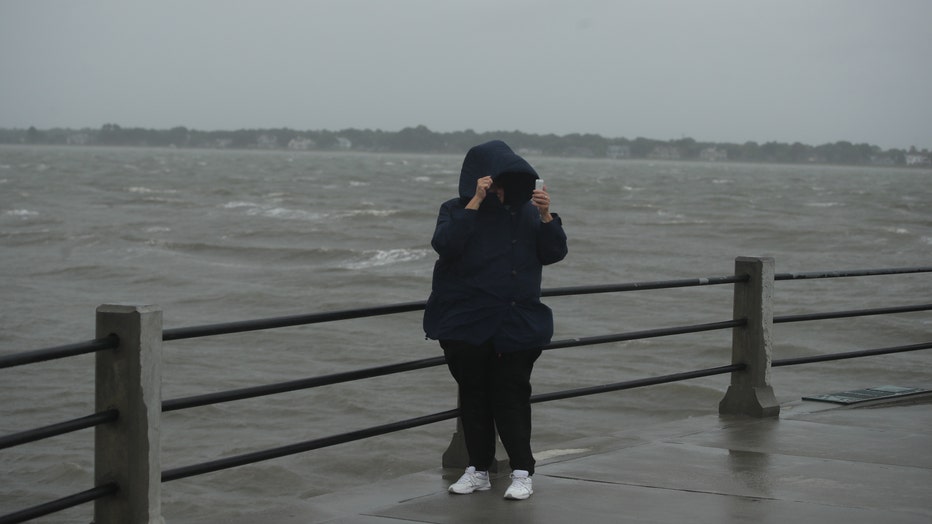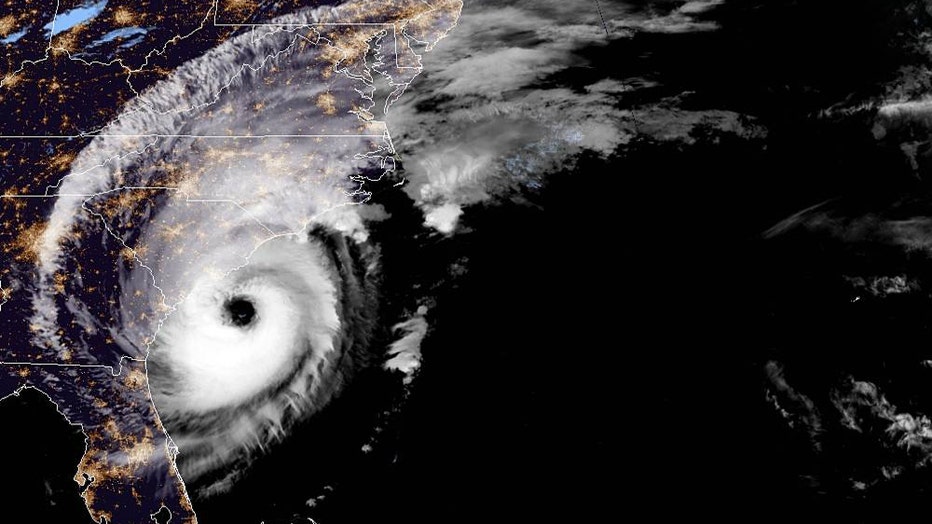Hurricane Dorian grazes Carolina coast, aims for Outer Banks

Carolinas coast braces for flooding as Dorian nears coast
The National Weather Service said hurricane warnings were in effect Thursday for the Carolina coasts up to Virginia.
CHARLESTON, S.C. - Hurricane Dorian sideswiped the Carolinas with shrieking winds, tornadoes and sideways rain Thursday as it closed in for a possible direct hit on the dangerously exposed Outer Banks. At least four deaths in the Southeast were blamed on the storm.
Twisters spun off by Dorian peeled away roofs and flipped trailers, and more than 250,000 homes and businesses were left without power as the hurricane pushed north along the coastline, its winds weakening after sunset to 100 mph (160 kph). Trees and power lines littered flooded streets in Charleston's historic downtown. Gusts had topped 80 mph (129 kph) in some areas.
North Carolina's Outer Banks, a thin line of islands that stick out from the U.S. coast like a boxer's chin, braced for a hit late Thursday or early Friday. To the north, Virginia was also in harm's way, and a round of evacuations was ordered there.
The damage from the same storm that mauled the Bahamas was mercifully light in many parts of South Carolina and Georgia as well, and by midafternoon many of the 1.5 million people who had been told to evacuate in three states were allowed to return.
But overnight winds will cause trees and branches to fall on power lines, and debris could block repair crews from accessing damaged lines, said Mike Burnette senior vice president of Electric Cooperatives, a North Carolina utility provider. Customers should prepare for prolonged power outages, he said.
"We have a long night ahead of us. Everyone needs to stay in a safe place and off the roads until the storm passes," North Carolina Gov. Roy Cooper said.
RELATED: Video shows tornadoes hitting Carolinas as re-energized Hurricane Dorian moves up coast

People are seen next to the sea as the outer bands of Hurricane Dorian approach in Charleston, South Carolina, United States on September 4, 2019. (Photo by Vural Elibol/Anadolu Agency via Getty Images)
About 150 evacuees were camped out at Charlotte Motor Speedway in North Carolina, speedway spokesman Scott Cooper said.
After leaving at least 30 people dead when it slammed the Bahamas with 185 mph (295 kph) winds, Dorian swept past Florida at a relatively safe distance, grazed Georgia, and then hugged the South Carolina-North Carolina coastline.
"I think we're in for a great big mess," said 61-year-old Leslie Lanier, who decided to stay behind and boarded up her home and bookstore on Ocracoke Island on the Outer Banks, making sure to move the volumes 5 to 6 feet (1.5 to 1.8 meters) off the ground.
The National Hurricane Center forecast as much as 15 inches (38 centimeters) of rain for the coastal Carolinas, with flash-flooding likely.
In Charleston, a historic port city of handsome antebellum homes on a peninsula that is prone to flooding even from ordinary storms, Dorian toppled some 150 trees, swamped roads and brought down power lines, officials said, but the flooding and wind weren't nearly as bad as feared.
Walking along Charleston's stone battery, college student Zachary Johnson sounded almost disappointed that Dorian hadn't done more.
"I mean, it'd be terrible if it did, don't get me wrong. I don't know — I'm just waiting for something crazy to happen, I guess," said Johnson, 24.

A satellite image taken on Sept. 5, 2019 shows Hurricane Dorian nearing the U.S. coast. (Photo credit: NOAA)
Dorian apparently spawned at least one tornado in North Myrtle Beach, South Carolina, damaging several homes, and another twister touched down in the beach town of Emerald Isle, North Carolina, mangling and overturning several trailer homes in a jumble of sheet metal. No immediate injuries were reported.
In coastal Wilmington, North Carolina, just above the South Carolina line, heavy rain fell horizontally, trees bent in the wind and traffic lights swayed as the hurricane drew near.
The four deaths attributed to the storm took place in Florida and North Carolina. All of them involved men who died in falls or by electrocution while trimming trees, putting up storm shutters or otherwise getting ready for the hurricane.
At 11 p.m. EDT, Dorian was centered about 35 miles (56 kilometers) southeast of Wilmington, North Carolina. The Category 2 storm had maximum sustained winds of 100 mph (161 kph) and was moving northeast at 13 mph (21 kph).
As it closed in on the Eastern Seaboard, Navy ships were ordered to ride out the storm at sea, and military aircraft were moved inland. More than 700 airline flights scheduled for Thursday and Friday were canceled. And hundreds of shelter animals were airlifted from coastal South Carolina to Delaware.
Tybee Island, Georgia, population 3,000, came through the storm without flooding. "If the worst that comes out of this is people blame others for calling evacuations, then that's wonderful," Mayor Jason Buelterman said.
By midday Thursday, coastal residents in Georgia and some South Carolina counties were allowed to go home.
Still, South Carolina Gov. Henry McMaster warned of new dangers ahead.
"Don't be surprised if there was water in your home. You might have animals, snakes. You don't know what might be in there, so be very careful as you return," he said.

